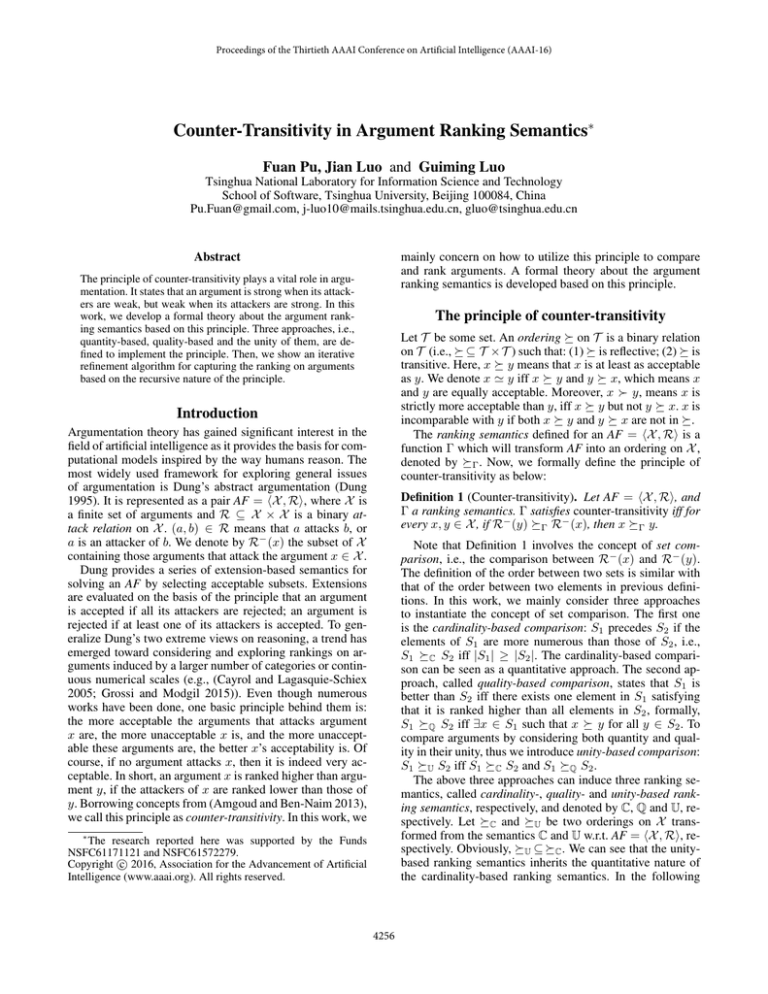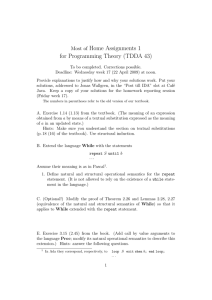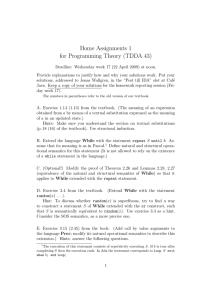
Proceedings of the Thirtieth AAAI Conference on Artificial Intelligence (AAAI-16)
Counter-Transitivity in Argument Ranking Semantics∗
Fuan Pu, Jian Luo and Guiming Luo
Tsinghua National Laboratory for Information Science and Technology
School of Software, Tsinghua University, Beijing 100084, China
Pu.Fuan@gmail.com, j-luo10@mails.tsinghua.edu.cn, gluo@tsinghua.edu.cn
mainly concern on how to utilize this principle to compare
and rank arguments. A formal theory about the argument
ranking semantics is developed based on this principle.
Abstract
The principle of counter-transitivity plays a vital role in argumentation. It states that an argument is strong when its attackers are weak, but weak when its attackers are strong. In this
work, we develop a formal theory about the argument ranking semantics based on this principle. Three approaches, i.e.,
quantity-based, quality-based and the unity of them, are defined to implement the principle. Then, we show an iterative
refinement algorithm for capturing the ranking on arguments
based on the recursive nature of the principle.
The principle of counter-transitivity
Let T be some set. An ordering on T is a binary relation
on T (i.e., ⊆ T × T ) such that: (1) is reflective; (2) is
transitive. Here, x y means that x is at least as acceptable
as y. We denote x y iff x y and y x, which means x
and y are equally acceptable. Moreover, x y, means x is
strictly more acceptable than y, iff x y but not y x. x is
incomparable with y if both x y and y x are not in .
The ranking semantics defined for an AF = X , R is a
function Γ which will transform AF into an ordering on X ,
denoted by Γ . Now, we formally define the principle of
counter-transitivity as below:
Introduction
Argumentation theory has gained significant interest in the
field of artificial intelligence as it provides the basis for computational models inspired by the way humans reason. The
most widely used framework for exploring general issues
of argumentation is Dung’s abstract argumentation (Dung
1995). It is represented as a pair AF = X , R, where X is
a finite set of arguments and R ⊆ X × X is a binary attack relation on X . (a, b) ∈ R means that a attacks b, or
a is an attacker of b. We denote by R− (x) the subset of X
containing those arguments that attack the argument x ∈ X .
Dung provides a series of extension-based semantics for
solving an AF by selecting acceptable subsets. Extensions
are evaluated on the basis of the principle that an argument
is accepted if all its attackers are rejected; an argument is
rejected if at least one of its attackers is accepted. To generalize Dung’s two extreme views on reasoning, a trend has
emerged toward considering and exploring rankings on arguments induced by a larger number of categories or continuous numerical scales (e.g., (Cayrol and Lagasquie-Schiex
2005; Grossi and Modgil 2015)). Even though numerous
works have been done, one basic principle behind them is:
the more acceptable the arguments that attacks argument
x are, the more unacceptable x is, and the more unacceptable these arguments are, the better x’s acceptability is. Of
course, if no argument attacks x, then it is indeed very acceptable. In short, an argument x is ranked higher than argument y, if the attackers of x are ranked lower than those of
y. Borrowing concepts from (Amgoud and Ben-Naim 2013),
we call this principle as counter-transitivity. In this work, we
Definition 1 (Counter-transitivity). Let AF = X , R, and
Γ a ranking semantics. Γ satisfies counter-transitivity iff for
every x, y ∈ X , if R− (y) Γ R− (x), then x Γ y.
Note that Definition 1 involves the concept of set comparison, i.e., the comparison between R− (x) and R− (y).
The definition of the order between two sets is similar with
that of the order between two elements in previous definitions. In this work, we mainly consider three approaches
to instantiate the concept of set comparison. The first one
is the cardinality-based comparison: S1 precedes S2 if the
elements of S1 are more numerous than those of S2 , i.e.,
S1 C S2 iff |S1 | ≥ |S2 |. The cardinality-based comparison can be seen as a quantitative approach. The second approach, called quality-based comparison, states that S1 is
better than S2 iff there exists one element in S1 satisfying
that it is ranked higher than all elements in S2 , formally,
S1 Q S2 iff ∃x ∈ S1 such that x y for all y ∈ S2 . To
compare arguments by considering both quantity and quality in their unity, thus we introduce unity-based comparison:
S1 U S2 iff S1 C S2 and S1 Q S2 .
The above three approaches can induce three ranking semantics, called cardinality-, quality- and unity-based ranking semantics, respectively, and denoted by C, Q and U, respectively. Let C and U be two orderings on X transformed from the semantics C and U w.r.t. AF = X , R, respectively. Obviously, U ⊆ C . We can see that the unitybased ranking semantics inherits the quantitative nature of
the cardinality-based ranking semantics. In the following
∗
The research reported here was supported by the Funds
NSFC61171121 and NSFC61572279.
c 2016, Association for the Advancement of Artificial
Copyright Intelligence (www.aaai.org). All rights reserved.
4256
Proposition 1. Let Q and U be the orderings on X computed by Algorithm ?? w.r.t. Q and U for AF = X , R,
respectively. It holds that U ⊆Q .
Example 1. Consider the AF with X = {x, y1 , y2 , y3 , z}
and R = {xRyi , yi Rz}, i = 1, 2, 3. The cardinality-based
ranking semantics gives C = {x y1 y2 y3 z}. Now, we calculate the other semantics by using Algorithm ??.
For the quality-based ranking semantics Q, the initial or(0)
dering is Q = {x y1 y2 y3 z}. Applying
section, we will show that it also inherits the recursive nature of the quality-based ranking semantics (i.e., the rank of
an argument relies on the rank of its attackers, which in turn
depends on the rank of their attackers, and so on).
The recursive nature of counter-transitivity
The recursive nature of Q and U provides a way of solving them by iteration. Here, we consider Algorithm ?? that
defines a ranking semantics for AF = X , R, which iteratively refines an ordering on X by applying the principle
of counter-transitivity. Let x (k) y denote the fact that the
rank of x is higher than or equal to the rank of y in iteration k of the algorithm. The algorithm begins with an initial ordering in which all arguments have equal ranks (see
line 3). The ordering in stage k + 1 is refined from the or(k)
dering in stage k by the function Refining(Γ ) described
(k+1)
as: (a) Let Γ
= ∅; (b) For all pairs of x and y in X , if
(k)
(k+1)
R− (y) Γ R− (x), then add the order x Γ
y to the
(k+1)
set Γ
. By iteratively applying the function Refining,
if there is no change between the current ordering and the
previous ordering, the algorithm terminates, and output the
current ordering as the chosen one (in line 7 and 8). The final ordering will be consistent with the principle of countertransitivity since if there exist a pair of arguments whose relative order should be refined to realize counter-transitivity,
then the algorithm will not terminate and will continue to
make further refinements.
(1)
Refining, we obtain Q = {x y1 y2 y3 z}. Here,
x is ranked above all other arguments as it has no attacker;
(0)
yi z due to R− (yi ) Q R− (z). Applying Refining
(2)
again, we have Q = {x z y1 y2 y3 }, where z is
(1)
ranked higher than yi due to R− (yi ) Q R− (z). Applying
(3)
Refining again, we also have Q = {x z y1 y2 y3 }. Then, the iteration process terminates, and the ordering
for this AF w.r.t. Q is Q = {x z y1 y2 y3 }.
For the unity-based ranking semantics U, the initial or(0)
dering is also U = {x y1 y2 y3 z}. After
(1)
applying the first Refining, we get U = {x y1 y2 y3 z}, in which yi z as |R− (yi )| < |R− (z)| and
(0)
R− (z) U R− (yi ). Actually, as it is assumed in the initial ordering that the quality of all arguments are the same,
thus, the first refinement ranks arguments merely based on
(1)
the quantity of their attackers, and we thus have C = U .
(2)
After the second refinement, we then obtain U = {x y1 y2 y3 , x z}, where z is incomparable with yi ,
(1)
since R− (yi ) U R− (z) is inconsistent with |R− (yi )| <
−
|R (z)|. The third refinement has the same result as the second one. Thus, U = {x y1 y2 y3 , x z} for
this AF. We can see that U ⊆ Q , which is compatible with
Proposition 1.
Theorem 1. Algorithm ?? necessarily converges with respect to Γ ∈ {Q, U}.
(0)
(1)
(2)
Since Γ ⊇ Γ ⊇ Γ ⊇ · · · is a decreasing sequence
of sets of orderings on arguments for Γ ∈ {Q, U}, and there
are only finitely many arguments, thus Algorithm ?? necessarily converges. Algorithm ?? will terminate after at most
|X | iterative calls to function Refining since each iteration
is just a refinement that makes the ordering more strict. In
the following, an example is presented to show how Algorithm ?? ranks arguments within the context of quality- and
unity-based semantics.
Conclusion
The work discusses the principle of counter-transitivity in
argumentation and addresses the issue of graded acceptability of arguments from a new perspective. It formalises three
ranking semantics based on three comparison criteria and an
iterative algorithm to compute two of those proposed semantics.
Algorithm 1: Solving ranking semantics by iteration
Input: X , R: argumentation framework;
(k)
Output: Γ : the (partial or complete) ordering on X ;
1 begin
2
k := 0;
(0)
3
Γ := {∀x, y ∈ X , x (0) y};
4
repeat
(k+1)
(k)
5
Γ
:= Refining(Γ ) ;
6
k := k + 1;
(k)
(k−1)
7
until Γ = Γ
;
(k)
8
return Γ ;
9 end
References
Amgoud, L., and Ben-Naim, J. 2013. Ranking-based semantics for
argumentation frameworks. In Scalable Uncertainty Management.
Springer. 134–147.
Cayrol, C., and Lagasquie-Schiex, M.-C. 2005. Graduality in argumentation. Journal Artificial Intelligence Research (JAIR) 23:245–
297.
Dung, P. M. 1995. On the acceptability of arguments and its fundamental role in nonmonotonic reasoning, logic programming and
n-person games. Journal of Artificial Intelligence 77(2):321–357.
Grossi, D., and Modgil, S. 2015. On the graded acceptability of arguments. In Proceedings of the Twenty-Fourth International Joint
Conference on Artificial Intelligence, 868–874. IJCAI.
4257







